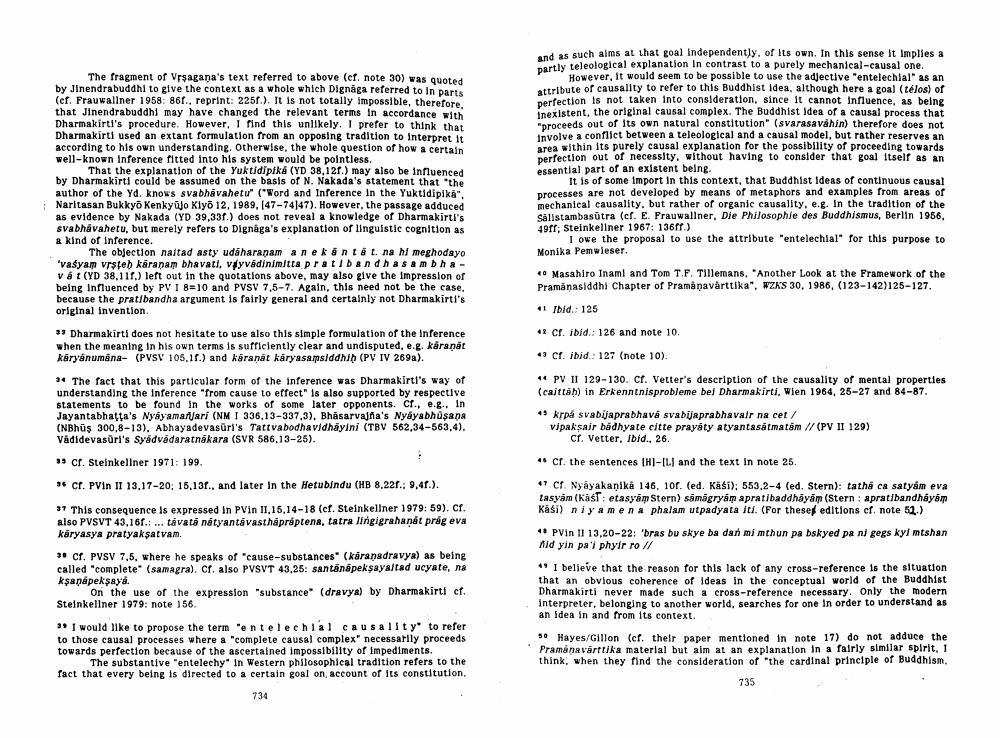________________
The fragment of Vrsagana's text referred to above (cf. note 30) was quoted by Jinendrabuddhi to give the context as a whole which Dignaga referred to in parts (cf. Frauwallner 1958 861., reprint: 225f.). It is not totally impossible, therefore, that Jinendrabuddhi may have changed the relevant terms in accordance with Dharmakirti's procedure. However, I find this unlikely. I prefer to think that Dharmakirti used an extant formulation from an opposing tradition to Interpret it according to his own understanding. Otherwise, the whole question of how a certain well-known inference fitted into his system would be pointless.
That the explanation of the Yuktidipika (YD 38,121.) may also be influenced by Dharmakirti could be assumed on the basis of N. Nakada's statement that the author of the Yd, knows svabhavahetu" ("Word and Inference in the Yuktidipika", Naritasan Bukkyo KenkyūJo Kiyo 12, 1989, 47-74147). However, the passage adduced as evidence by Nakada (YD 39,331.) does not reveal a knowledge of Dharmakirti's svabhavahetu, but merely refers to Dignaga's explanation of linguistic cognition as & kind of Inference.
The objection naitad asty udáharanam anekantat. na hi meghodayo 'vasyam vrsteh karanam bhavati, vyvadinimitta pratibandhasambha - vát (YD 38.111.) left out in the quotations above, may also give the impression of being influenced by PVI 8=10 and PVSV 7,5-7. Again, this need not be the case, because the pratibandha argument is fairly general and certainly not Dharmakirti's original Invention.
and as such aims at that goal Independently, of its own. In this sense It Implies a artly teleological explanation in contrast to a purely mechanical-causal one.
However, it would seem to be possible to use the adjective "entelechial" as an attribute of causality to refer to this Buddhist idea, although here a goal (télos) of merfection is not taken into consideration, since it cannot influence as being inexistent. the original causal complex. The Buddhist idea of a causal process that
roceeds out of its own natural constitution" (svarasavahin) therefore does not involve a conflict between a teleological and a causal model, but rather reserves an area within its purely causal explanation for the possibility of proceeding towards perfection out of necessity. without having to consider that goal itself as an essential part of an existent being.
It is of some import in this context, that Buddhist ideas of continuous causal processes are not developed by means of metaphors and examples from areas of mechanical causality, but rather of organic causality, e.. In the tradition of the Salistambasūtra (cf. E. Frauwallner. Die Philosophie des Buddhismus, Berlin 1956, 49ff, Steinkellner 1967: 13611.)
I owe the proposal to use the attribute "entelechial" for this purpose to Monika Pemwleser.
Masahiro Inami and Tom T.F. Tillemans. "Another Look at the Framework of the Pramanasiddhi Chapter of Pramanavarttika", WZKS 30, 1986, (123 - 142)125-127.
41 Ibid. 125
42 cr. ibid.: 126 and note 10.
39 Dharmakirti does not hesitate to use also this simple formulation of the Inference when the meaning in his own terms is sufficiently clear and undisputed, e.g. karapat karyanumána- (PVSV 105.11.) and karanat karyasamsiddhi (PV IV 269a).
49 Cf. ibid.: 127 (note 10).
** PV II 129-130. cf. Vetter's description of the causality of mental properties (cajttah) in Erkenntnisprobleme bei Dharmakirti, Wien 1964, 25-27 and 84-87.
** The fact that this particular form of the inference was Dharmakirti's way of understanding the inference "from cause to effect" is also supported by respective statements to be found in the works of some later opponents. cf. e.g.. In Jayantabhatta's Nyayamartlari (NM I 336,13-337.3), Bhäsarvalnia's Nyáyabhusana (NBhūş 300,8-13). Abhayadevasūri's Tattvabodha vidhãyini (TBV 562,34-563,4). Vadidevasūri's Syadvádaratnákara (SVR 586.13-25).
49 krpá svabijaprabhavá svabījaprabhavalr na cet/ vipaksair badhyate citte prayáty atyantasatmatam // (PV II 129)
Cf. Vetter, ibid., 26.
33 cr. Steinkellner 1971: 199.
** Cf. the sentences (H]-IL) and the text in note 25.
56 cr. PVin II 13.17-20, 15.131., and later in the Hetubindu (HB 8.221.: 9.40.).
47 Ch. Nyayakanika 146, 10r. (ed. Kasi); 553,2-4 (ed. Stern): tatha ca satyam eva tasyam (kast: etasyam Stern) samāgryām apratibaddhayam (Stern: apratibandhayam Kasi) niya mena phriam utpadyata it. (For thesef editions cf. note 51.)
37 This consequence is expressed in PVin II,15,14-18 (cf. Steinkellner 1979: 59). Cf. also PVSVT 43,16f.: ... tavata natyantávasthapraptena, tatra lingigrahanat prag eva karyasya pratyaksatvam.
4. PVin II 13,20-22: 'bras bu skye ba dan mimthun pa bskyed pa ni gegs kyi mtshan Nid yin pa'l phyir ro //
3. cf. PVSV 7.5, where he speaks of 'cause-substances' (karanadravya) as being called "complete (samagra). Cr. also PVSVT 43,25: santānapeksaya tad ucyate, na kşanapeksaya.
On the use of the expression "substance" (dravya) by Dharmakirti cf. Steinkellner 1979: note 156.
49 I believe that the reason for this lack of any cross-reference is the situation that an obvious coherence of Ideas in the conceptual world of the Buddhist Dharmakirti never made such a cross-reference necessary. Only the modern Interpreter, belonging to another world, searches for one in order to understand as an idea in and from its context.
1 I would like to propose the term 'entelechial causality to refer to those causal processes where a "complete causal complex" necessarily proceeds towards perfection because of the ascertained impossibility of impediments.
The substantive 'entelechy" in Western philosophical tradition refers to the fact that every being is directed to a certain goal on account of its constitution.
50 Hayes/Gillon (cf. their paper mentioned in note 17) do not adduce the Pramanavarttika material but aim at an explanation in a fairly similar spirit. I think, when they find the consideration of the cardinal principle of Buddhism.
735
734




